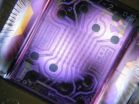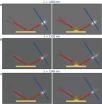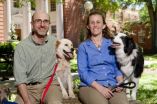(Press-News.org) Stanford researchers have developed a new biosensor microchip that could significantly speed up the process of drug development. The microchips, packed with highly sensitive "nanosensors," analyze how proteins bind to one another, a critical step for evaluating the effectiveness and possible side effects of a potential medication.
A single centimeter-sized array of the nanosensors can simultaneously and continuously monitor thousands of times more protein-binding events than any existing sensor. The new sensor is also able to detect interactions with greater sensitivity and deliver the results significantly faster than the present "gold standard" method.
"You can fit thousands, even tens of thousands, of different proteins of interest on the same chip and run the protein-binding experiments in one shot," said Shan Wang, a professor of materials science and engineering, and of electrical engineering, who led the research effort.
"In theory, in one test, you could look at a drug's affinity for every protein in the human body," said Richard Gaster, MD/PhD candidate in bioengineering and medicine, who is the first author of a paper describing the research that was published online this month by Nature Nanotechnology.
The power of the nanosensor array lies in two advances. First, the use of magnetic nanotags attached to the protein being studied – such as a medication – greatly increases the sensitivity of the monitoring.
Second, an analytical model the researchers developed enables them to accurately predict the final outcome of an interaction based on only a few minutes of monitoring data. Current techniques typically monitor no more than four simultaneous interactions and the process can take hours.
"I think their technology has the potential to revolutionize how we do bioassays," said P.J. Utz, associate professor of medicine (immunology and rheumatology) at Stanford University Medical Center, who was not involved in the research.
Members of Wang's research group developed the magnetic nanosensor technology several years ago and demonstrated its sensitivity in experiments in which they showed that it could detect a cancer-associated protein biomarker in mouse blood at a thousandth of the concentration that commercially available techniques could detect. That research was described in a 2009 paper in Nature Medicine.
The researchers tailor the nanotags to attach to the particular protein being studied. When a nanotag-equipped protein binds with another protein that is attached to a nanosensor, the magnetic nanotag alters the ambient magnetic field around the nanosensor in a small but distinct way that is sensed by the detector.
"Let's say we are looking at a breast cancer drug," Gaster said. "The goal of the drug is to bind to the target protein on the breast cancer cells as strongly as possible. But we also want to know: How strongly does that drug aberrantly bind to other proteins in the body?"
To determine that, the researchers would put breast cancer proteins on the nanosensor array, along with proteins from the liver, lungs, kidneys and any other kind of tissue that they are concerned about. Then they would add the medication with its magnetic nanotags attached and see which proteins the drug binds with – and how strongly.
"We can see how strongly the drug binds to breast cancer cells and then also how strongly it binds to any other cells in the human body such as your liver, kidneys and brain," Gaster said. "So we can start to predict the adverse affects to this drug without ever putting it in a human patient."
It is the increased sensitivity to detection that comes with the magnetic nanotags that enables Gaster and Wang to determine not only when a bond forms, but also its strength.
"The rate at which a protein binds and releases, tells how strong the bond is," Gaster said. That can be an important factor with numerous medications.
"I am surprised at the sensitivity they achieved," Utz said. "They are detecting on the order of between 10 and 1,000 molecules and that to me is quite surprising."
The nanosensor is based on the same type of sensor used in computer hard drives, Wang said.
"Because our chip is completely based on existing microelectronics technology and procedures, the number of sensors per area is highly scalable with very little cost," he said.
Although the chips used in the work described in the Nature Nanotechnology paper had a little more than 1,000 sensors per square centimeter, Wang said it should be no problem to put tens of thousands of sensors on the same footprint.
"It can be scaled to over 100,000 sensors per centimeter, without even pushing the technology limits in microelectronics industry," he said.
Wang said he sees a bright future for increasingly powerful nanosensor arrays, as the technology infrastructure for making such nanosensor arrays is in place today.
"The next step is to marry this technology to a specific drug that is under development," Wang said. "That will be the really killer application of this technology."
INFORMATION:
Other Stanford researchers who participated in the research and are coauthors of the Nature Nanotechnology paper are Liang Xu and Shu-Jen Han, both of whom were graduate students in materials science and engineering at the time the research was done; Robert Wilson, senior scientist in materials science and engineering; and Drew Hall, graduate student in electrical engineering. Other coauthors are Drs. Sebastian Osterfeld and Heng Yu from MagArray Inc. in Sunnyvale. Osterfeld and Yu are former alumni of the Wang Group.
New biosensor microchip could speed up drug development, Stanford researchers say
2011-04-20
ELSE PRESS RELEASES FROM THIS DATE:
The Wisconsin Labor Union Battle's Implications for New York
2011-04-20
New York has closely followed Wisconsin's political battle concerning the power of labor unions -- with good reason. Wisconsin has long been at the nation's forefront in unionization and employment reform. In fact, "The Dairy State" was the first state to enact a workers' compensation law when Gov. Francis E. McGovern signed its passage 100 years ago, in 1911.
Because of Wisconsin's storied tradition of progressively establishing workers' rights, New York is keeping close tabs on how the partisan conflict plays out. Often seen as the workers' rights benchmark, ...
Minimizing side effects from chemoradiation could help brain cancer patients live longer
2011-04-20
PHILADELPHIA—Minimizing neurological side effects in patients with high-grade glioma from chemoradiation may result in improved patient survival, a new study from radiation oncologists at the Kimmel Cancer Center at Jefferson suggests. These findings were reported in the April issue of the British Journal of Cancer.
The researchers found that the occurrence of early side effects, such as fatigue and loss of short-term memory, that manifest during or soon after treatment is significantly associated with both late side effects (after 90 days) and overall survival in patients ...
Repeat Offenders: Multiple DUI Arrests Bring Serious Consequences
2011-04-20
Steve Urbansky aspires to be Lorain, Ohio's newest grounds crew member. The 46-year-old ran his Kia hatchback into a snow bank on the 13th of February. When the police arrived on the scene, Urbansky explained that he was "just trying to mow the sidewalk."
Urbansky then failed a field sobriety test and confessed to drinking at home before he got behind the wheel. Police then found an opened can of beer in Urbansky's glove compartment. Urbansky, who has two prior DUI convictions (in 1997 and 1999), was charged with operating a vehicle while intoxicated, failure ...
Miniature invisibility 'carpet cloak' hides more than its small size implies
2011-04-20
WASHINGTON, April 19—Invisibility cloaks are seemingly futuristic devices capable of concealing very small objects by bending and channeling light around them. Until now, however, cloaking techniques have come with a significant limitation—they need to be orders of magnitude larger than the object being cloaked.
This places serious constraints on practical applications, particularly for the optoelectronics industry, where size is a premium and any cloaking device would need to be both tiny and delicate.
An international team of physicists from the Technical University ...
Atlanta Flooring Company Glover's Flooring America to Celebrate 80th Anniversary in 2011
2011-04-20
Atlanta carpet and flooring company, Glover's Flooring America, will celebrate its 80th year of business in 2011. Glover's is a family-owned Atlanta flooring company offering huge selections of carpet, hardwood floors, tile, laminate, vinyl and area rugs.
With eight decades of experience, Glover's is strengthened by a knowledgeable and passionate design staff that works with interior designers, contractors and homeowners to satisfy every customer's flooring need.
"We pride ourselves on providing the highest quality flooring and a staff that can understand and ...
New research suggests right-handedness prevailed 500,000 years ago
2011-04-20
Right-handedness is a distinctively human characteristic, with right-handers outnumbering lefties nine-to-one. But how far back does right-handedness reach in the human story?
Researchers have tried to determine the answer by looking at ancient tools, prehistoric art and human bones, but the results have not been definitive.
Now, David Frayer, professor of anthropology at the University of Kansas, has used markings on fossilized front teeth to show that right-handedness goes back more than 500,000 years. He is the lead author (with colleagues in Croatia, Italy and Spain) ...
The National Trust Supports the Plant and Protect Campaign
2011-04-20
The National Trust is supporting the Plant and Protect campaign which has been launched by Copella.
As English apple growth declines, new independent research has highlighted how out of touch with their heritage varieties Britons are. The study of over 1,000* Britons commissioned by apple juice experts, Copella, has revealed that over three quarters of the population (76%) think that the Granny Smith is an English variety - when in fact, it's Australian.
The study also revealed that only 11% of Britons are able to identify English apple varieties from a list of names ...
Landmark study reveals breed-specific causes of death in dogs
2011-04-20
Athens, Ga. – Dog owners and veterinarians have long relied on a mix of limited data and anecdotal evidence to assess which breeds are at risk of dying from various conditions, but a new University of Georgia study provides a rare and comprehensive look at causes of death in more than 80 breeds.
The study, published in the current edition of the Journal of Veterinary Internal Medicine, can be used to create breed-specific health maintenance programs and is a starting point for future studies that will explore the genetic underpinnings of disease in dogs.
"If we can ...
The National Trust Reveals 'Lost' Maze at Cliveden
2011-04-20
The National Trust has revealed a 'lost' maze in the gardens at Cliveden in Buckinghamshire that disappeared for over half a century and has now been re-created using over 1,000 two metre (six feet six inches) high yew trees.
The fully-fledged maze is based on one that was built for Lord Astor in 1894 but had ceased to be maintained since the mid-1900s.
The new maze, a horticultural project on a scale rarely seen these days, has taken two years to create, using over 1,000 metres of steel edging and 120 tonnes of gravel to produce 500 metres of path over one third ...
Green environments essential for human health
2011-04-20
Research shows that a walk in the park is more than just a nice way to spend an afternoon. It's an essential component for good health, according to University of Illinois environment and behavior researcher Frances "Ming" Kuo.
"Through the decades, parks advocates, landscape architects, and popular writers have consistently claimed that nature had healing powers," Kuo said. "But until recently, their claims haven't undergone rigorous scientific assessment."
Kuo is also the director of the Landscape and Human Health Laboratory at the U of I and has studied the effect ...



